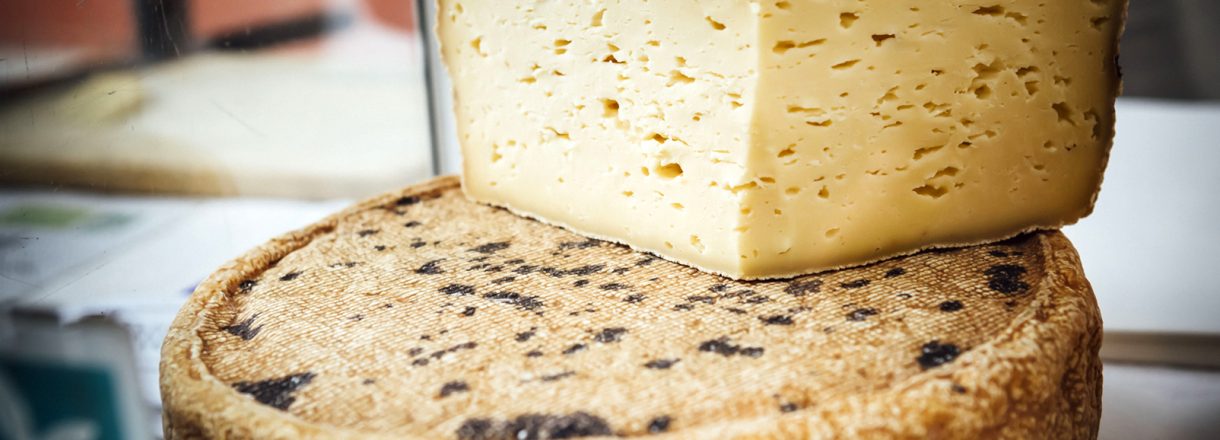The Couserans is the second largest cheese-producing area in the Pyrenees and benefits, in particular, from a PGI for the raw-milk Tomme des Pyrénées cheese and the Ariège Pyrenees “Valeurs Parc” label.
The Ariège Pyrenees and, in particular, the Couserans valleys – after the Atlantic Pyrenees – produce the largest volumes of cheese within the massif.

However, since 1996, only the pasteurised version has been granted a PGI (Protected Geographical Indication). The PGI indicates the existence of close links between the region and the specific characteristics of the product.
For 20 years, craftsmen and farm producers have been asking for changes to the specifications in order to have a Pyrenean cheese that truly represents their local area.
- Introduction of farmhouse and artisanal production
- Introduction of milks other than cow’s milk
- Modification of the production area
- Introduction of raw milk and thus recognition of cheeses with natural rinds
- Introduction of obligations regarding farming practices (compulsory grazing, origin of the feed given to the animals, etc.)
Proposed by cheese-making farmers and artisanal manufacturers, who wish to see their know-how recognised, and supported by the Ariège Pyrenees Nature Park, the European Commission has provided a long-awaited modification of the specifications. From now on, all tomme cheeses from the Pyrenees will be eligible for the PGI label. This is a true guarantee for the consumer and recognition of the work of an entire industry.

Cheese and honey festival
The Pyrenean cheese and honey festival takes place every summer to celebrate these fantastic products, in addition to actions carried out to support authentic local production carried out all year round by the Regional Nature Park (PNR) of the Ariège Pyrenees.
Look out for the « Valeurs Parc » label in our shops !
www.parc-pyrenees-ariegeoises.fr
The secret of the ancient production of raw-milk tomme
In the middle of the herd work two very busy cowherds, sporting clogs. One of them crouches on his wooden lérou* to collect the precious milk, as creamy as whipped cream. After this, the milk is left to rest and gradually becomes even more creamy. Then, with his cherry-wood cuilhé*, the man collects the generous cream by scraping the surface of the liquid and deposits it in his cubétou*. .
As the milk heats up, he slowly rotates his toudeilho* between his outstretched hands – always in the same direction – in order to dilute the rennet until the curd forms a compact mass caught between the branches. The mixture is then crumbled, salted and kneaded, and poured into moulds placed under a press.
These cheeses will be turned every eight days after a minimum of two months spent maturing in the barns at altitude, which will eventually be brought down from the mountain pastures at the end of the summer to be sold in the village square.
The milking techniques employed at our dairy today are more modern, but the curdling, moulding, draining and salting processes which give the cheese its taste are still done by hand. Tomme cheese made from cow, goat or sheep’s milk is the result of an ancestral tradition passed down to local producers. It can be enjoyed by itself, but it is also used in a number of recipes in our mountain cuisine.
Cheese maker’s lexicon
- Lérou : Wooden jug carved from a single piece of timber, 40 to 60 cm high, slightly curved and used to collect the milk during milking.
- Cuilhé : Spoon in the shape of a shovel, almost at right angles, with a deep, flared base, useful for skimming milk.
- Cubétou : Container dug out of the trunk of a fir tree with a lid and a strap to collect the milk’s cream
- Toudeilho : A long, barked stick with five branches, made from a boxwood tree top cut about ten metres above the ground, which is rolled between the palms of the hands to turn the milk and avoid lumps.
How could you come to the mountains and not think about cheese ? How could you visit the Pyrenees and not think about cheese ? Who doesn’t associate winter with cheese? Well, that’s three good reasons to offer you a recipe for processed cheese, right ?
Discover the recipe for Rogaliflette … Read more here
 Local and gastronomic know-how
Local and gastronomic know-how  Living traditions
Living traditions  Thermalism
Thermalism  Must-see sights
Must-see sights  In the heart of the Ariège Pyrenees Regional Nature Park
In the heart of the Ariège Pyrenees Regional Nature Park  Hiking in the Couserans
Hiking in the Couserans  Cycling and mountain biking
Cycling and mountain biking  Hikes for little legs
Hikes for little legs  Thrills
Thrills  We have plenty of good runs in Guzet !
We have plenty of good runs in Guzet !  Swimming spots
Swimming spots  The Couserans Trail-Biking Area
The Couserans Trail-Biking Area  Winter resorts and activities
Winter resorts and activities  Where to sleep ?
Where to sleep ?  Where to eat ?
Where to eat ?  To do ?
To do ? 













